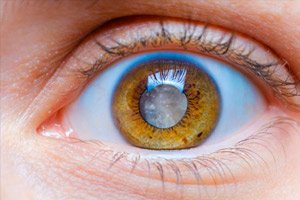
All iLive content is medically reviewed or fact checked to ensure as much factual accuracy as possible.
We have strict sourcing guidelines and only link to reputable media sites, academic research institutions and, whenever possible, medically peer reviewed studies. Note that the numbers in parentheses ([1], [2], etc.) are clickable links to these studies.
If you feel that any of our content is inaccurate, out-of-date, or otherwise questionable, please select it and press Ctrl + Enter.
Pollen, industrial emissions and ozone: a triad of risks to lens transparency
Last reviewed: 09.08.2025

What the scientists found: The world's largest prospective study of more than 200,000 adults over 50 in China found a clear link between annual ground-level ozone (O₃) levels and the risk of age-related cataracts, a leading cause of vision loss and blindness in older people. The study was published in the journal Pubs.acs.
Design and scale
- Population: 215,000 cataract-free individuals included from 31 provinces in China.
- Follow-up: Up to 10 years of follow-up of the initial diagnosis of cataract confirmed in medical records.
- Exposure assessment: Annual mean 8-hour maximum ozone concentrations were calculated from ground-based and satellite monitoring data.
Key Results
Risk increases with O₃ concentration:
For every 10 ppb (parts per billion) increase in ozone, the annual mean level increased the Hazard Ratio (HR) of age-related cataracts by 8% (HR = 1.08; 95% CI: 1.05–1.11).
Subgroups with increased vulnerability:
Women were more sensitive (HR = 1.10) than men (HR = 1.06).
People over 65 and those living in rural areas showed an even higher risk.
Nuclear subtype cataract: This type, in which the central nucleus of the lens becomes cloudy, was most strongly associated with long-term ozone exposure.
Damage mechanisms
- Oxidative stress: Ozone, a powerful oxidizer, when it hits the surface of the eye, triggers a cascade of reactive oxygen species that destroy proteins and lipids in the lens.
- Chronic inflammation: Low-level inflammatory effects on the conjunctiva and cornea eventually penetrate deeper into the visual apparatus.
Healthcare implications
- Air quality standards review: results support tightening ground-level ozone limits, especially in densely populated and rural areas.
- Public and Clinician Education: Ophthalmologists and physicians should consider chronic ozone exposure as a risk factor for cataracts along with UV radiation and metabolic diseases.
- Prevention: Wearing protective eyewear outdoors, using air purifiers indoors, and educating seniors about peak pollution hours can slow the progression of lens opacity.
"We were hoping to find a link between ozone and respiratory diseases. But it was a surprise to us that it had such a pronounced effect on the eyes," said Dr. Li Zheng, lead author of the study.
The authors emphasize several important points:
Broad spectrum of damage
“We expected a link between ozone and lung disease, but we found that chronic exposure also causes significant damage to the lens of the eye,” says Dr. Li Zheng. “This broadens our understanding of the risks to poor ecology.”Vulnerability of older and rural residents
“The increased risk in people over 65 and those living in rural areas is likely due to a combination of increased time spent outdoors and limited access to health care,” adds co-author Prof Hui Wang.Need to revise standards
“Our results justify revising the maximum permissible levels of ground-level ozone at the national and international levels, as current standards do not protect the eyes of older people,” Dr. Zheng concludes.
These findings highlight the need for a relentless fight against air pollution to avoid losing sight in the invisible battle with the ghostly ozone.
